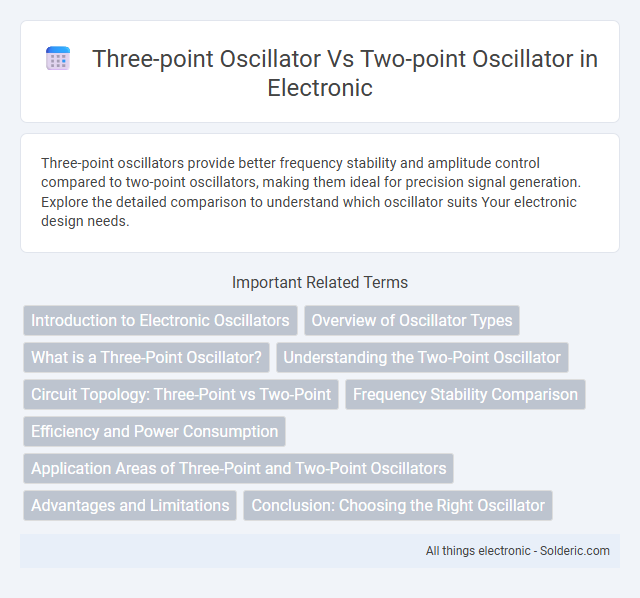Three-point oscillators provide better frequency stability and amplitude control compared to two-point oscillators, making them ideal for precision signal generation. Explore the detailed comparison to understand which oscillator suits Your electronic design needs.
Comparison Table
| Feature | Three-Point Oscillator | Two-Point Oscillator |
|---|---|---|
| Feedback Points | Three distinct points for feedback | Two points for feedback |
| Complexity | More complex circuitry | Simpler design |
| Stability | Higher frequency stability | Lower compared to three-point |
| Frequency Range | Typically wider range | Moderate range |
| Application | High-precision oscillators, RF circuits | Basic oscillators, low-frequency applications |
| Phase Shift | Utilizes three-phase shift stages | Uses two-phase shift stages |
| Amplitude Control | Better amplitude control | Less accurate amplitude control |
Introduction to Electronic Oscillators
Electronic oscillators generate continuous waveforms by converting direct current into alternating current without an input signal. Three-point oscillators use three active terminals, providing better frequency stability and reduced noise compared to two-point oscillators, which utilize only two active terminals and simpler circuit configurations. The choice between these oscillators impacts signal purity, stability, and ease of integration in radio frequency and signal generation applications.
Overview of Oscillator Types
Three-point oscillators use positive feedback derived from three nodes creating stable oscillations widely utilized in radio frequency generation, characterized by higher frequency stability. Two-point oscillators rely on two feedback nodes, often simpler in design, commonly found in lower-frequency applications with less complex circuitry. The choice between three-point and two-point oscillators depends on frequency requirements and circuit complexity, impacting overall performance in electronic communication systems.
What is a Three-Point Oscillator?
A Three-point oscillator is an electronic oscillator circuit that uses three active components or nodes to establish feedback and sustain oscillations, enhancing frequency stability and signal purity. Unlike Two-point oscillators that rely on simpler feedback paths, Three-point oscillators commonly achieve better performance in high-frequency applications by balancing phase shift and gain across multiple points. Your choice between these oscillators depends on circuit complexity, desired frequency accuracy, and application requirements.
Understanding the Two-Point Oscillator
The Two-Point Oscillator offers a simplified feedback mechanism by connecting only two key points in the circuit, contrasting with the Three-Point Oscillator's more complex configuration involving three connections for stability and frequency control. Your understanding of the Two-Point Oscillator centers on its straightforward phase shift and gain requirements, which make it easier to design but potentially less stable at varying frequencies. This oscillator type is ideal for applications requiring basic sine wave generation with minimal components and design complexity.
Circuit Topology: Three-Point vs Two-Point
Three-point oscillators utilize an additional feedback point in the circuit topology, enhancing phase control and stability compared to two-point oscillators. This configuration typically involves three connections--input, output, and feedback--allowing precise frequency determination and improved oscillation startup. In contrast, two-point oscillators rely on simpler feedback loops with only input and output nodes, often resulting in less stable frequency output and increased sensitivity to component variations.
Frequency Stability Comparison
Three-point oscillators offer enhanced frequency stability compared to two-point oscillators due to their improved feedback control and reduced phase noise. The additional control point in three-point oscillator circuits minimizes frequency drift caused by temperature variations and component aging. This results in more consistent oscillation frequency, making three-point oscillators preferred in high-precision applications.
Efficiency and Power Consumption
Three-point oscillators generally offer higher efficiency due to better frequency stability and reduced phase noise, resulting in lower power consumption for precise applications. Two-point oscillators typically consume more power as they rely on simpler configurations with less effective feedback control, which can increase energy losses. Optimizing your circuit design with a three-point oscillator can enhance overall power efficiency, especially in low-power or battery-operated devices.
Application Areas of Three-Point and Two-Point Oscillators
Three-point oscillators are widely used in radio frequency circuits, signal generators, and waveform synthesis due to their enhanced frequency stability and improved gain characteristics. Two-point oscillators find application primarily in audio frequency generation, low-power signal sources, and basic timing circuits where simplicity and ease of implementation are prioritized. Both oscillator types play crucial roles in communication systems, instrumentation, and electronic testing equipment, tailored to their specific frequency and stability requirements.
Advantages and Limitations
Three-point oscillators offer greater frequency stability and improved waveform purity compared to two-point oscillators, making them ideal for precision applications such as RF signal generation. However, their circuit complexity and component count are higher, which can increase cost and design difficulty. Two-point oscillators, while simpler and more cost-effective, often suffer from lower frequency stability and phase noise, limiting their use in high-performance systems.
Conclusion: Choosing the Right Oscillator
Three-point oscillators offer greater stability and frequency precision compared to two-point oscillators, making them ideal for high-performance RF and communication applications. Two-point oscillators are simpler in design and cost-effective, suitable for low-frequency or less demanding signal generation tasks. Selecting the right oscillator depends on the required frequency stability, design complexity, and application-specific performance criteria.
Three-point oscillator vs Two-point oscillator Infographic

 solderic.com
solderic.com